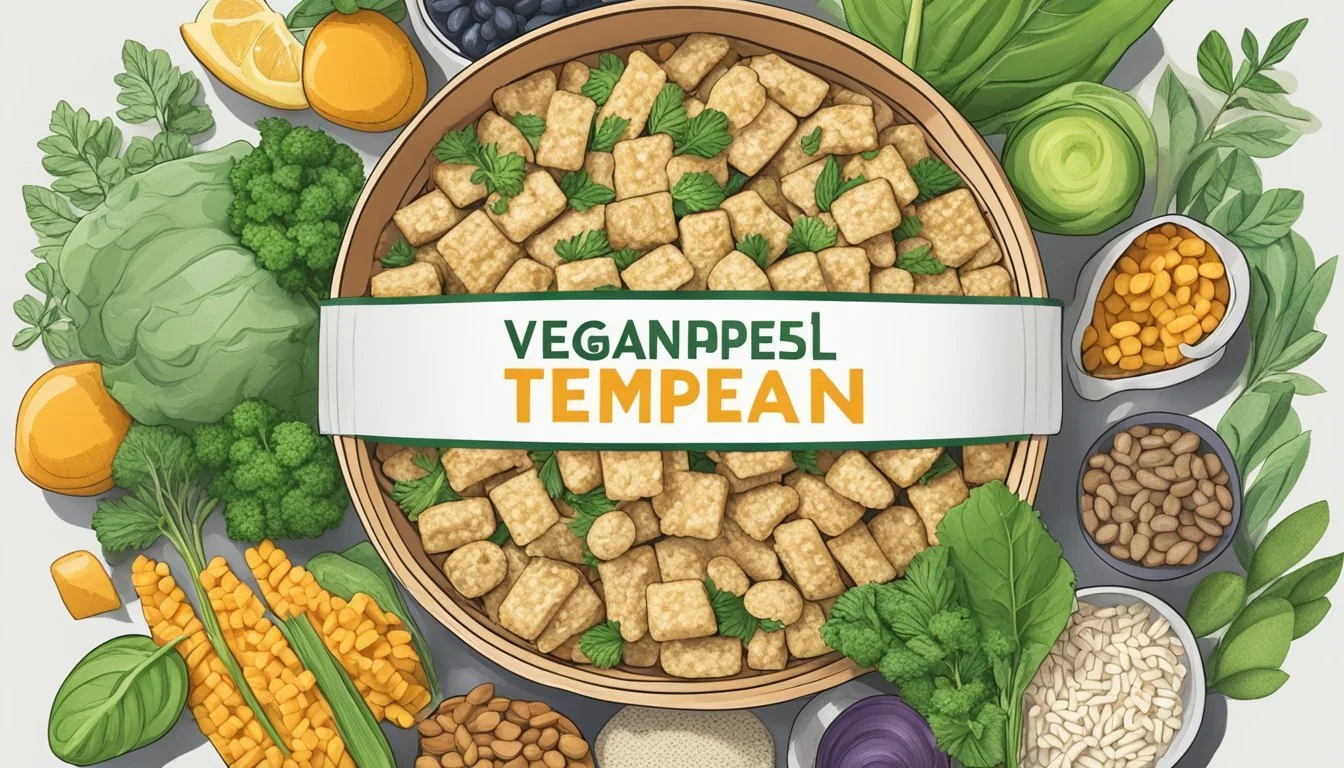Is Tempeh Vegan?
Unveiling the Truth About This Plant-Based Protein
Tempeh (What wine goes well with tempeh?) is a plant-based protein source lauded for its versatility and nutritional benefits. It is indeed vegan, as it is made from fermented soybeans that are formed into a compact cake. This traditional Indonesian food (What wine goes well with Indonesian food?) has gained popularity worldwide, particularly among those following a vegan diet due to its high protein content that serves as an excellent meat substitute.
The soybeans in tempeh undergo a natural culturing and controlled fermentation process that binds the beans into a firm, sliceable cake. Sometimes grains and other beans are mixed in, adding to its nutrient density and textural variety. Vegan consumers often embrace tempeh for its whole-foods origin, minimal processing, and absence of animal products, making it a staple in plant-based cooking.
The unique fermentation process tempeh goes through not only contributes to its distinct nutty flavor and chewy texture but also increases its digestibility and enhances its nutritional profile. Rich in fiber, vitamins, and minerals, tempeh is not just suitable for those on a vegan diet; it also offers a sustainable, healthful alternative to animal proteins for anyone looking to diversify their diet.
What Is Tempeh?
Tempeh is a versatile, high-protein plant-based food known for its rich nutrient profile and its fermentation process, which not only enhances its flavor but also its digestibility and nutritional richness.
Origins and History
Originating from Indonesia, tempeh is a traditional food made by fermenting soybeans with a starter culture called Rhizopus oligosporus. This fermentation binds soybeans into a dense, cake-like form. It has been a staple in Indonesian cuisine for centuries and is celebrated for its earthy, nutty flavor, and its substantial, meaty texture.
Nutritional Profile
Tempeh's nutritional profile is impressive. It is high in protein, providing about 30 grams per cup, making it a favorite among those following vegan or vegetarian diets. In addition to its protein content, tempeh is rich in essential minerals such as calcium and iron, and is also a good source of vitamins, particularly those in the B-complex group. The fiber content in tempeh not only aids in digestion but also contributes to a feeling of fullness. The fermentation process contributes further by producing natural antibiotics that are believed to increase the body's resistance to infections.
Veganism and Plant-Based Proteins
In the context of veganism, protein sources are exclusively plant-based, excluding all animal products. A variety of plant proteins fulfill a vegan's dietary needs, with tempeh standing out as a nutrient-rich option.
Defining Veganism
Veganism involves abstaining from the use of animal products, particularly in diet. It is a lifestyle choice that seeks to exclude all forms of exploitation of, and cruelty to, animals for food, clothing, or any other purpose. Plant-based proteins are a cornerstone of the vegan diet, providing essential nutrients that are traditionally obtained from animal products. These proteins come from sources such as legumes, grains, nuts, seeds, and soy products like tofu, edamame, and tempeh.
Tempeh in Vegan Diets
Tempeh is a traditional Indonesian food made from fermented soybeans. It forms a firm patty whose texture is commonly appreciated as a meat substitute in vegan diets. Tempeh is not only a vegan meat alternative but also a source of complete protein, meaning it contains all nine essential amino acids.
Nutritional Breakdown: A typical serving of tempeh (about 3 ounces) provides approximately 8 grams of protein.
Preparation and Use: The versatility of tempeh allows it to be cut into various shapes and marinated to enhance its flavor. It can be grilled, baked, or sautéed and used in a myriad of vegan recipes as a satisfying meat replacement.
Incorporated into a well-planned vegan diet, tempeh offers not just high-quality protein but also valuable nutrients that support overall health. Its role in vegan nutrition is well-recognized and often recommended by dietitians for those seeking wholesome plant-based protein alternatives.
Cooking With Tempeh
Tempeh is a versatile ingredient in vegan cooking, providing a nutritious and protein-rich base for a variety of dishes. Understanding the right preparation and cooking methods can turn tempeh into a delightful meal.
Preparation Techniques
Before cooking, tempeh often benefits from marination. This process enhances flavor and can tenderize the dense texture. One can marinate tempeh in mixtures containing soy sauce, vinegar, or citrus juices, along with spices and herbs for at least an hour, or ideally, overnight. For even cooking, cut tempeh into uniform pieces such as cubes for stir fry or thin strips for tempeh bacon.
Cooking Methods
There are multiple ways to cook tempeh, each yielding different textures and flavors:
Grill: Apply a light coating of oil and grill the marinated tempeh until it has charred marks and a smoky flavor.
Steam: Steaming for about 10 minutes softens the tempeh and can reduce its bitterness.
Roast: Suitable for achieving a firmer, chewier texture. Roast in the oven at 350°F until golden brown.
Sauté: Quick and easy, sautéing allows for a crisp exterior. Use a non-stick pan with minimal oil.
Bake: Baking tempeh slabs or cubes can produce a crispy outside while keeping the inside moist.
Air Fryer: Air fryer tempeh is a healthier option that yields a crunchy texture without the added oil.
Tempeh Recipes
Popular vegan tempeh recipes showcase its adaptability in different cuisines:
Tempeh Stir Fry: Cube and sauté tempeh with a slew of vegetables like bell peppers and broccoli. Serve over grains for a hearty meal.
Tempeh Tacos: Crumbled and cooked with taco seasoning, wrapped in tortillas with toppings.
Teriyaki Tempeh: Glazed with a teriyaki marinade and grilled or baked for a sweet and savory flavor.
Vegan BLT Tempeh Sandwich: Thinly sliced and baked tempeh layered with lettuce and tomato in a classic sandwich setup.
Vegan Tempeh Bolognese: Crumbled tempeh simmers in a rich tomato sauce, perfect over pasta.
Tempeh Fries: Strips of seasoned tempeh, baked or air-fried until crispy.
Baked Tempeh: Simple yet delicious, marinated and then baked to use in a myriad of dishes.
Each of these methods can transform the humble tempeh into an irresistible and nutritious part of any meal.
Tempeh's Texture and Flavor
Tempeh, a traditional Indonesian food made from fermented soybeans, possesses a firm, meaty texture and a rich, nutty flavor profile, distinguishing it from other plant-based proteins.
Culinary Versatility
Tempeh's firm texture makes it an excellent choice for various culinary applications. It can easily be sliced, cubed, or crumbled, allowing it to integrate seamlessly into a wide array of dishes. This adaptability enables chefs and home cooks alike to incorporate tempeh into:
Salads: Providing a satisfying chewiness
Sandwiches: As a hearty filling
Tacos: When crumbled, it resembles ground meat
Stews: Adding substance and absorbing flavors
Flavor Pairings
Tempeh's nutty flavor carries subtle mushroom-like notes and stands out even when coupled with bold ingredients. This makes it an ideal canvas for flavor pairings with various sauces and condiments, enhancing its natural taste and complementing other components in a dish. It pairs well with:
Avocado: For a creamy, rich contrast
Spicy sauces: They bring out tempeh's innate savoriness
Marinades: Which infuse the tempeh with a range of flavors
Tempeh absorbs seasonings well, meaning it can be marinated or sauced to suit the taste profile of a particular cuisine, whether it's an Asian-inspired soy sauce glaze or a smoky barbecue sauce.
Tempeh Beyond Food
Tempeh is a versatile ingredient often lauded for its nutritional benefits and culinary versatility. However, its impact stretches beyond the kitchen, contributing to sustainable living and finding roles outside of food preparation.
Sustainable Choice
Tempeh is a product of fermented soybeans, which makes it a sustainable protein source due to soy's lower environmental footprint compared to animal agriculture. It is relatively low in fat and does not require the high resource inputs of meat production. Additionally, the fermentation process used in creating tempeh further minimizes waste, as it converts legumes and sometimes other grains into more digestible and nutritious forms. This fermentation also enhances tempeh’s status as a sustainable choice in the culinary world, where consumers are increasingly seeking out foods that support environmental health.
Cultural Significance: Tempeh's roots in Indonesian culture emphasize traditional methods that are inherently sustainable.
Pantry Staple: Tempeh has become a pantry staple found in supermarkets across the globe, offering a less overprocessed alternative to meat.
Non-Culinary Uses
Despite its primary role in nutrition, tempeh can have applications outside of human cuisine. Its ingredients and fermentation process have potential in various fields, such as agriculture, where fermented products can aid soil health. Tempeh's production processes and byproducts could also have implications in sustainable packaging materials, where the demand for biodegradable options is on the rise. Research into these applications is ongoing but highlights the broader potential of tempeh beyond the plate.
Agricultural Use: Utilizing tempeh fermentation byproducts to enhance soil fertility and structure.
Biopackaging Development: Exploring fermented soy product residues as bases for eco-friendly packaging solutions.
Health Considerations
When considering tempeh as a dietary choice, it's essential to understand the allergen contents and its nutritional profile. This section will explore tempeh's status as a gluten-free option and its array of health benefits.
Gluten-Free and Allergens
Tempeh is a naturally gluten-free food made from fermented soybeans, making it a suitable option for individuals with celiac disease or gluten sensitivities. However, cross-contamination can be an issue if tempeh is produced in facilities that also handle wheat or other gluten-containing ingredients. Consumers should check labels for certification or allergen warnings. It's also vital to note that while tempeh is a brilliant inclusion in a vegan diet, those with soy allergies should avoid it, as it is a soy product.
Health Benefits of Tempeh
Tempeh stands out in the vegan diet for its robust nutritional benefits. It is notably low in fat and calories but high in protein and fiber. A single cup of cooked tempeh can provide around 30 grams of protein, contributing significantly to the protein requirements of an average person. Additionally, tempeh is rich in vitamins and minerals such as calcium, B-vitamins, and iron. Moreover, it contains phosphorus, which is crucial for maintaining bone health. These attributes make tempeh an excellent food choice for promoting overall well-being and nutritional balance in a vegan diet. Its health benefits extend beyond just protein, delivering a diverse range of nutrients that are essential for a healthy body.
Integrating Tempeh into Meals
Tempeh, as a versatile and plant-based protein, can be seamlessly incorporated into a variety of meals throughout the day. Whether used as a meat substitute in traditional dishes or as a key ingredient in vegan classics, tempeh offers a nutritious and satisfying option.
Breakfast Options
The morning meal can be invigorated with tempeh by preparing tempeh bacon, which can be thinly sliced and marinated in a mixture of soy sauce, liquid smoke, and maple syrup before baking or frying until crisp. Serve as a side or incorporate into sandwiches or with avocado toast. Additionally, tempeh crumbles seasoned with turmeric and black salt can simulate a hearty, vegan scramble.
Lunch and Dinner Ideas
For lunch and dinner, the scope for tempeh is wide, ranging from substantive salads featuring strips of marinated tempeh, to heartier options like tacos and stews. One can enhance vegan bowls with grilled tempeh topped with a smoky barbecue sauce, pairing well with radish and chipotle corn salsa for added zest.
Tacos: Crumble tempeh and season with cumin, chili powder, and lime juice; fill tortillas and top with vegan cheese or fresh salsa.
Salads: Toss tempeh cubes with a tangy peanut sauce and add to leafy greens.
Cacciatore: Braise tempeh pieces with bell peppers, tomatoes, and Italian herbs to create a vegan version of this classic dish.
Piccata: Bathe fried tempeh cutlets in a zingy sauce made from capers, parsley, and lemon juice, serving over pasta or a bed of spinach.
Sloppy Joes: Use tempeh as a filling meat alternative, cooked down with onions and a rich tomato sauce for a comforting and familiar taste.
Stir-fry: Combine tempeh cubes with a variety of colorful vegetables and sauté in a ginger-garlic sauce; serve over brown rice or quinoa for a filling meal.
Whether baked, sautéed, or crumbled, tempeh can be a centerpiece or complementary addition to vegan recipes, presenting a nutritious and adaptable option for any meal.
Cultural and Regional Aspects
Tempeh has distinct roots in Indonesian cuisine while also having carved a niche for itself in Western diets, especially among the plant-based communities.
Tempeh in Indonesian Cuisine
Originating from Indonesia, particularly on the island of Java, tempeh is a traditional source of protein. In Indonesia, tempeh is often utilized in a variety of dishes and is commonly served with sambal, a type of chilli sauce that is popular across Southeast Asia. It showcases the regional flavors and spices, reflecting Indonesia's rich culinary heritage.
Tempeh in Western Diets
In Western countries, tempeh has been adopted into global cuisine as a versatile vegan ingredient. It has become increasingly popular due to its high-protein content and its ability to absorb flavors, making it a substantial meat substitute. Western culinary approaches see tempeh marinated, baked, or fried, often incorporated into dishes ranging from burgers to salads.







